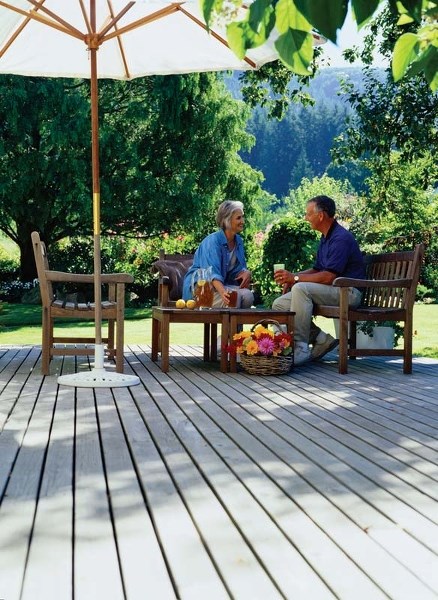Like other backyard trends that extend living space – indoor/outdoor rugs, furniture, lighting and even outdoor kitchens – the deck is a focal point for outdoor living and a much-desired space for entertaining, cooking, eating or just lounging with a book.
It’s not easy going from vision to reality when creating a spot to enjoy the fine weather of our brief summers. Should you replace an existing deck using the same foundation, spend thousands for a maintenance-free deck of your dreams or buy a more modest DIY wooden deck kit from the local big-box store? Only your budget, tastes and time will tell, but all are viable options and readily available.
Deck packages are available at The Home Depot, where designers sit with customers and talk through all the elements of the deck – size and height, number of boards, railings, fasteners, even renting a post-hole auger. After a product list is created, goods are quickly gathered up and brought to the till.
“It’s deck season, where we can do five to 10 deck designs in a day,” said St. Albert The Home Depot store manager Sotirie Togias.
“You have three options for materials – pressure-treated wood, cedar wood or composite.”
If the budget allows, consumers are choosing composite, a PVC-wood blend board that is maintenance-free and comes in a host of designer colours.
“Grey is now the most popular. A top seller for house dĂ©cor, it’s now the hot colour for decks too,” Togias said. “The price is coming down for composite, so I think it’ll eventually be the standard for decks.”
At The Deck Store in Edmonton, a mecca for all things deck-related, composite has been growing in popularity for some 10 years, thanks to improvements in stain-resistance and expand/contract issues.
Store owner Jim Slater said composite products can still be several times the price of wood, but when customers realize that framing and labour costs remain the same whether wood or composite, they often go with new technology.
“There’s no painting or staining to do, no knot holes, and no cracking. You only need to shovel the snow off in winter,” Slater said, adding that decks can cost $50,000 and beyond, with most averaging about $10,000.
While 80 per cent of his business is tear-out replacement decks, Slater said buyers are looking for touches like rock skirting and privacy screens, flooring made of tile or interlocking recycled rubber pavers, patio heaters and – the hottest trend – a patterned deck floor.
“Most customers pick at least two colours for composite deck boards, from our choice of 65. They want to match it to deck cushions or the home’s vinyl siding – there’s not as much call for the old green lumber anymore,” he said.
For anything beyond replacing a few floorboards, St. Albert residents need to check with the city regarding building a deck on their front or back property, even if deconstructing and reconstructing on the exact same space.
In these cases, the city wants to insure the previous deck was done to code before the rebuild, said Chelsea Thompson, development officer with the city’s department of planning and development.
If a deck is in your future this summer, plan ahead (especially if permits are needed), and enjoy that outdoor space.
The rules
• Section 8.6 of the land use bylaw, available to view online at stalbert.cabuilding-a-deck, has all the regulations for putting up a deck in the city. Restrictions are in place regarding corner lots, how far from the property line you can build, height restrictions and permits needed.<br /><br />• Any deck over .06 metres high (just under two feet), requires railings and both a development permit and building permit (about $125).<br /><br />• Getting a building permit triggers an inspection by the city at different times during the deck-building process.<br /><br />• During peak building months, it takes an estimated 15 business days to process the applications and permits.




